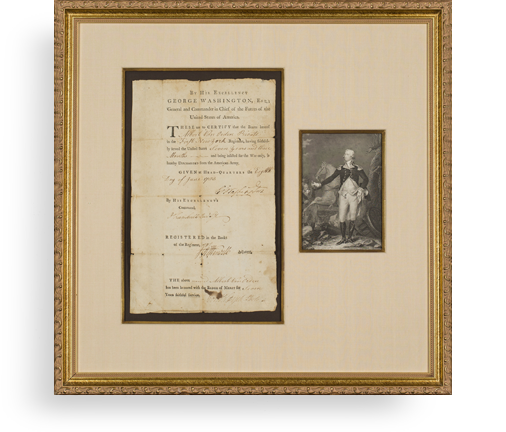President James Madison Exercises Executive Clemency and Pardons a Sailor Sentenced to Death for Piracy in a Famous Trial


A very uncommon pardon signed by both Madison and Secretary of State James Monroe, the last one we found having reached the market in the early 1980s.
The schooner George Washington was owned and captained by noted Philadelphia merchant Uriah Phillips Levy, and had a crew of six men. On July 15, 1811, after picking up casks of wine and $2500 hard coinage (about $50,000 today) at Tenerife in the Canary Islands, the ship went to the Cape Verde...
The schooner George Washington was owned and captained by noted Philadelphia merchant Uriah Phillips Levy, and had a crew of six men. On July 15, 1811, after picking up casks of wine and $2500 hard coinage (about $50,000 today) at Tenerife in the Canary Islands, the ship went to the Cape Verde Islands and came into port. On January 9, 1812, Levy went to pay a visit to another ship, being rowed in by two of the men. When he sought to return, the ship was gone; a search revealed the cables had been cut. On board the schooner, chief mate Samuel Tully had taken over and ordered the men to hoist the sails, which the two rowmen refused to do and instead insisted on taking the small rowboat and leaving the ship. The cook John Owen wanted to join them, but Sully said no. Now there were just Tully, his helper John Dalton, a cook and a seaman named George Cummings. The ship put to sea. Cummings, who was not part of the plan to seize the ship, became uneasy with what was happening, and about two weeks into the venture fought with Sully. Sully and Dalton threw him overboard and left him to die at sea. Upon reaching port, the cook, also not involved in the scheme, was given a few dollars to keep him quiet, and Sully and Dalton kept the rest and concocted a cover story. However, Owen was simply not able to live with the deeds and the lies, and soon approached an American captain moored in the same harbor and told him the truth. Dalton and Sully were arrested and returned to the United States for trial.
The grand jurors returned three bills of indictment, one for piratically and feloniously running away with the schooner George Washington from the care of her master, and taking the casks of wine and cash on board; another was for the murder of George Cummings on the high seas; and the third for feloniously scuttling and casting away the vessel. The men plead not guilty. At the trial, Levy and the cook appeared as witnesses, and the men were convicted and sentenced to death. Dalton’s attorney had made the point that Dalton was not a principal, but an accessory, and should be treated differently than Sully; this distinction would in time save Dalton’s life. The executions were scheduled for December 10, 1812, in Boston. The trial is included in the book, American State Trials: A Collection of Important and Interesting Criminal Trials.
Dalton sought presidential intervention to prevent his execution. After suspending the execution, President Madison finally granted Dalton his pardon in this Document signed as President, Washington, June 5, 1813. “Whereas, sentence of death was passed by the Circuit Court of the United States held for the District of Massachusetts, at Boston, upon a certain John Dalton, who was at its October term 1812, duly convicted of Piracy, and the President of the United States did respite the execution of the said sentence, from time to time, until the 15th day of June instant: Now be it known that I James Madison, President of the United States of America, for divers good causes and considerations do grant to the said John Dalton a full, free and entire pardon for the offence aforesaid, and the judgment of the Court thereupon, hereby remitting and releasing all pains and penalties by him incurred by reason of the premises.” Also signed by James Monroe as Secretary of State.
So Dalton was pardoned. Tully was hung as scheduled, with an estimated 15,000 people in attendance at the gallows. That would be almost half the population of the town at the time.
This is an uncommon pardon signed by Madison and Monroe. A search of public sale records going back 40 years turns up only one having reached that market

Frame, Display, Preserve
Each frame is custom constructed, using only proper museum archival materials. This includes:The finest frames, tailored to match the document you have chosen. These can period style, antiqued, gilded, wood, etc. Fabric mats, including silk and satin, as well as museum mat board with hand painted bevels. Attachment of the document to the matting to ensure its protection. This "hinging" is done according to archival standards. Protective "glass," or Tru Vue Optium Acrylic glazing, which is shatter resistant, 99% UV protective, and anti-reflective. You benefit from our decades of experience in designing and creating beautiful, compelling, and protective framed historical documents.
Learn more about our Framing Services









































































































